
Syrphidae
Hoverflies

Episyrphus balteatus - Derbyshire, England - July 2010
Hoverflies are a quite conspicuous group. Look at any patch of flowers in late spring or summer and you will have a high chance of seeing at least one species either feeding on the pollen and nectar, resting, or hovering motionless in the air close-by.

Episyrphus balteatus - Derbyshire, England - July 2010
Many species have courtship and territorial behaviours that involve the males displaying remarkably precise flying manoeuvres. In some, the male that is able to demonstrate its superior ability in hovering motionless, holding its position precisely in air while correcting for breezes and air currents, is more likely to attract the females and to hold the most desirable territories.
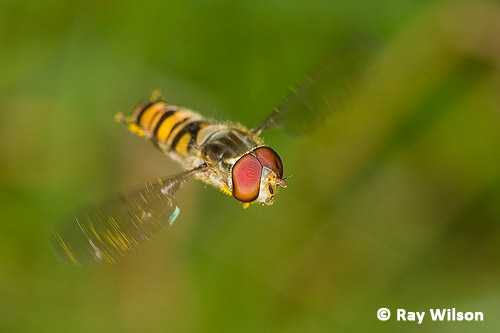
Episyrphus balteatus - County Kerry, Republic of Ireland - July 2008
As a group, hoverflies are generally regarded as beneficial insects. The adults are important pollinators of many flowers and in some cases the pollen load attached to the hairs on their bodies is at least equal to that of bees. Many also have larvae that are voracious predators of agricultural and horticultural pests. An example is the hoverfly shown above, whose nocturnal larvae feed on aphids.
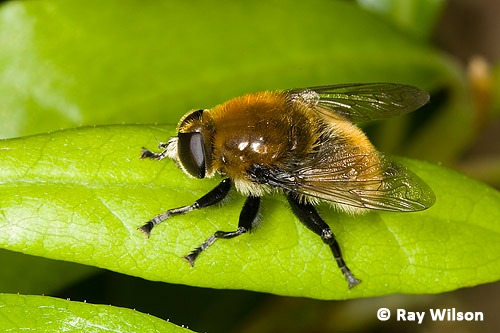
Large Narcissus Fly (Merodon equestris) - Gwynedd, Wales - May 2008
One not so beneficial species that is often regarded as a horticultural pest is the large, bee-like Merodon equestris whose larvae consume the bulbs of garden flowers such as daffodils and crocuses.
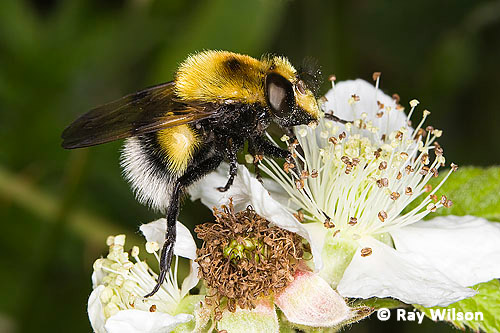
Volucella bombylans - Cheshire, England - June 2008
Members of the genus Volucella are generally large, robust bee and wasp mimics. V. bombylans (above) is a remarkably good mimic of bumblebees that has several different colour forms. Its larvae live as scavengers in the nests of bumblebees and social wasps, eating nest debris under the combs and occassionally attacking its host's larvae too. V. pellucens (below) has similar habits.

Volucella pellucens - Derbyshire, England - July 2010
Another group of bee-mimic hoverflies are the members of the genus Eristalis. These are all quite similar in appearance to the European Honeybee (Apis mellifera).
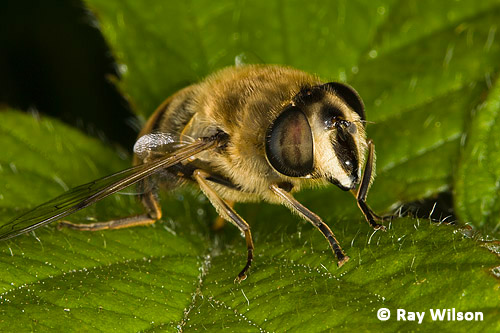
Drone Fly (Eristalis tenex) - Gwynedd, Wales - May 2008
E. tenex's common name reflects its close similarity to male honeybees. It is one of Britain's commonest hoverflies and is one of the few species that has been recorded in every month of the year due to the female's habit of hibernating in houses and other sheltered crevices and emerging on warm winter days.
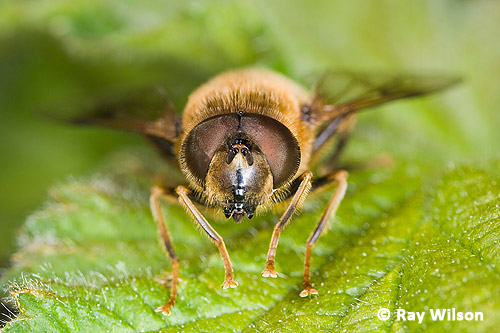
Eristalis pertinax - Cheshire, England - April 2009
Another abundant member of the genus is E. pertinax. It is easily separated from the similar E. tenex and E. similis by its orange front tarsus that entirely lack any dark markings .
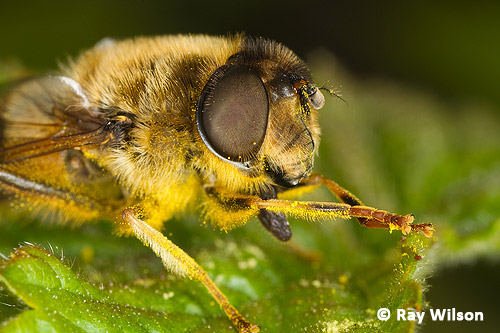
Eristalis pertinax - Derbyshire, England - June 2010
Below is one of only 2 species of British hoverflies that have spotty eyes. Both are quite similar and are separated by the extent of the hairs on their eyes: E. aeneus has hairs only on the upper part of the eyes whereas on E. sepulchralis the hairs extend well beyond halfway down. E. sepulchralis is more likely to be found in inland locations than E. aeneus, which is a predominantly coastal species.

Eristalinus sepulchralis - Cheshire, England - August 2008
Episyrphus balteatus (below and the 3 photos at the top of the page) is an easily recognisable species since it is the only hoverfly found in Britain and Ireland that has double black bands on the 3rd and 4th abdominal segments (tergites).
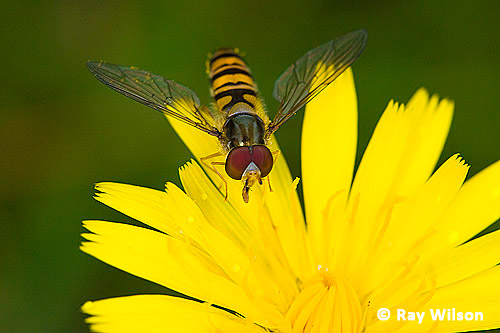
Episyrphus balteatus - County Kerry, Republic of Ireland - July 2008
Many other hoverflies are not so easy to identify. For example, although the Sphaerophoria genus are distinctive and easily seperable from other hoverflies, identification to species is very difficult and it is not even certain how many species are present in the British fauna.
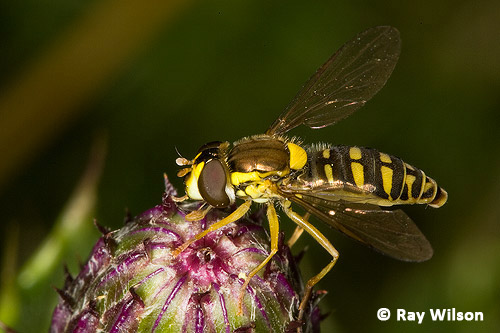
Sphaerophoria sp. - Anglesey, Wales - July 2008
Members of the extremely common hoverflies in the genus Syrphus are also tricky to identify and males of S. rectus and S. vitripennis are impossible to tell apart using morphological features. As well as the two species already mentioned the male below could also be S. ribesii since separation of this species requires an examination of the extent of yellow on the hind femur and/or the presence of microtrichia on the basal cell of the wing. The possibility of S. torvus can be eliminated in this case due to the lack of hairs on the eyes.

male Syrphus sp. - Derbyshire, England - July 2010
Female Syrphus hoverflies are slightly easier to identify, but still require care and examination of a number of features to confirm their identification. I should mention here that it is easy to distinguish the sexes in hoverflies. Males have large eyes that meet on the top of the head (see above photo), whereas in females the eyes are separate and there is a gap between them on the top of the head (below).

female Syrphus vitripennis - Cheshire, England - June 2008
The distinctively long-snouted Rhingia campestris is a very common hoverfly. It is most abundant whereever there are cows nearby, since its larvae feed on cow dung.
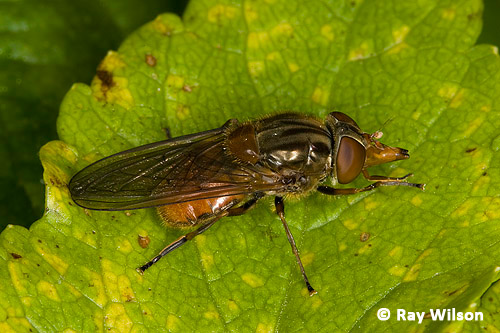
Rhingia campestris - Gwynedd, Wales - May 2008
The adult's long snout is an adaptation that allows the flies to feed on trumpet-shaped flowers such as Bugle (as demonstrated below).
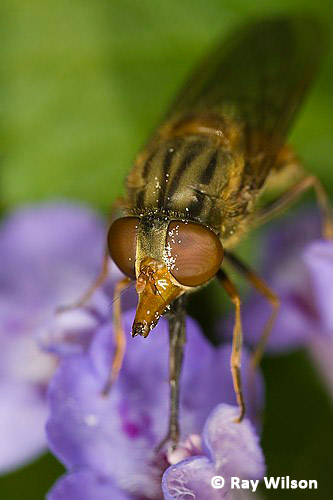 |
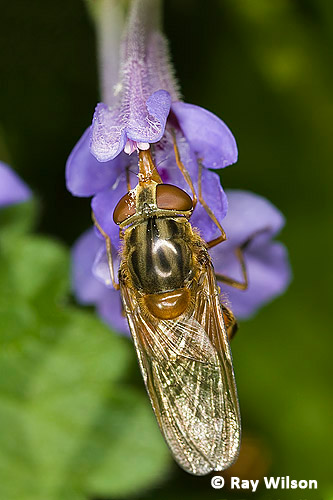 |
Rhingia campestris - Cheshire, England - May 2009
The combination of bold black and yellow stripes on the thorax and distinctive black markings on the abdomen readily distinguish the genus Helophilus.
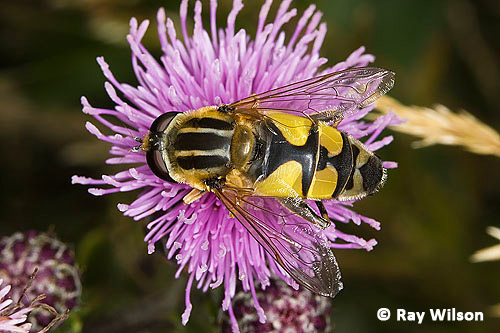
Helophilus trivittatus - Anglesey, Wales - July 2008
Although fairly uncommon, H. trivittatus can often be found feeding on thistles in coastal areas.

Helophilus trivittatus - Anglesey, Wales - July 2008
It is easily distinguished from the other members of its genus by its entirely yellow face.
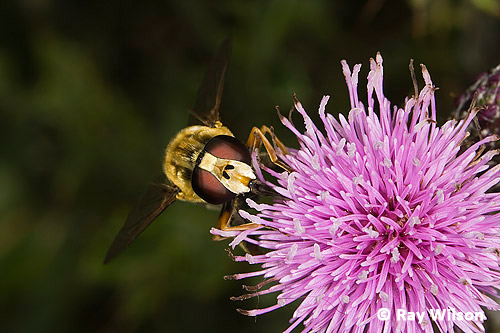
Helophilus trivittatus - Anglesey, Wales - July 2008
By far the commonest member of the Helophilus genus is H. pendulus which occurs abundantly throughout Britain and Ireland.
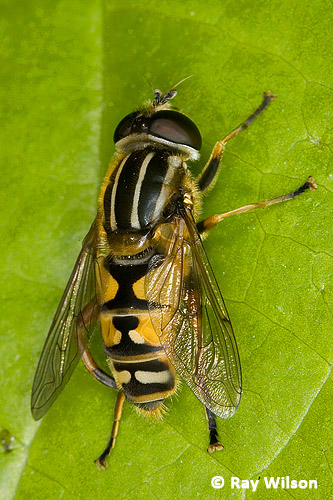
Helophilus pendulus - Cheshire, England - June 2007 |
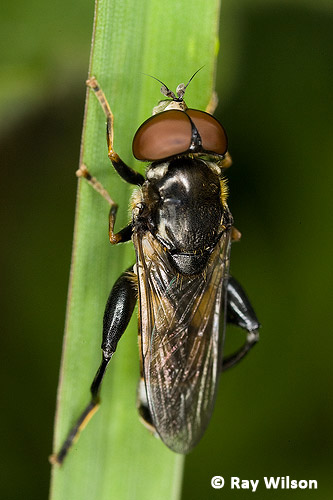
Tropidia scita - Lancashire, England - May 2009 |
The distinctive shape of the swollen hind femurs of Tropida scita (above right) are a good aid to its identification. It is a denizen of fenland and marshes where it is often found resting on reeds.
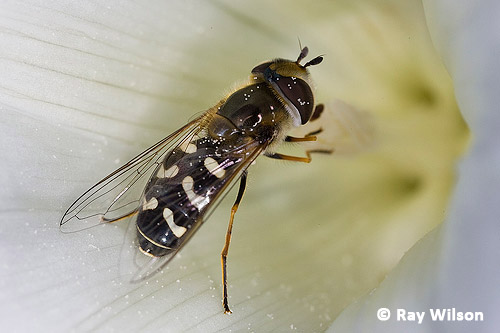
Scaeva pyrastri - Cheshire, England - August 2009
Scaeva pyrastri (above) is not considered to be a permanent resident in Britain and its numbers fluctuate wildly from year to year. Adults are thought to arrive as migrants from the continent and then breed here during the summer.

male Leucozona glaucia - Anglesey, Wales - July 2008
Leucozona glaucia has a patchy distribution within Britain and Ireland. In areas where it occurs, it prefers Umbellifer flowers in sunny spots along woodland edges and rides.
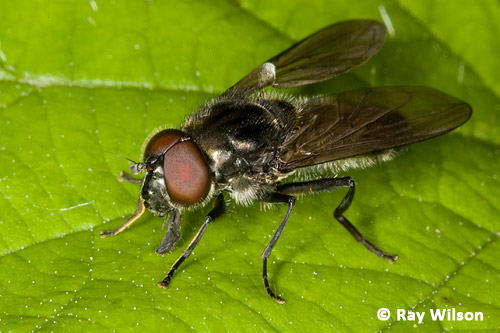
probably a male Platycheirus ambiguus - Gwynedd, Wales - June 2008
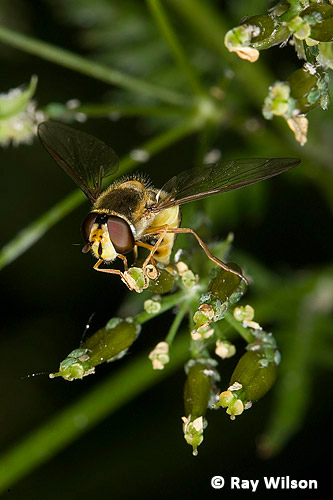
Syrphus sp. ovipositing on Aphid-infested Umbellifer flowers - Wirral, England - June 2007
Ray Wilson owns the copyright of all images on this site.
They may not be used or copied in any form without prior written permission.
raywilsonphotography@googlemail.com